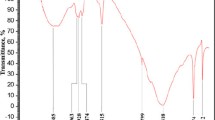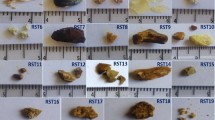Summary
This study was performed to clarify the movement of calcium in the pancreas of dogs with chronic pancreatitis, using scanning and transmission electron microscopes (SEM, TEM) equipped with X-ray elemental microanalyzers. Eleven adult mongrel dogs underwent incomplete ligation of the pancreatic duct. After the procedure, the levels of pancreatic enzymes in the serum did not change for 9 mo, but the endocrine function was reduced gradually. Of all dogs, 5 revealed pancreatic sclerosis, and 2 at 9 mo had calculi, 2–4 mm in size, in the small pancreatic duct. SEM examination revealed the intralobular fibrosis and irregularity of the pancreatic duct wall, and TEM examination demonstrated the amorphous or crystalloid substances and secreted granules in the acinar lumen or ductule. In elemental analysis spectra using SEM, a high calcium peak was seen in the pancreatic duct wall. In elemental analysis spectra using TEM, a high calcium peak was observed in the amorphous or crystalloid substances, and a high ratio of Ca/K was seen in these substances. Calcium was also detected in the secreted granules or microvilli These results suggest that there is a process of calculus formation based on the congregation of the intraductular substances containing a large quantity of calcium.
Similar content being viewed by others
References
Sarles H. Chronic calcifying pancreatitis—chronic alcoholic pancreatitis.Gastroenterology 1974; 66: 604–616.
Sarles H, Tiscornia O, Palasciano G, Brasca A, Hage G, Devaux MA, Gullo L. Effects of chronic intragastric ethanol administration on canine exocrine pancreatic secretion.Scand J Gastroenterol 1972; 8: 85–96.
Konishi K. Experimental pancreatic lithiasis.Jpn J Gastroenterol 1976; 73: 917–927.
Takayama T. Pathophysiological study of experimental pancreatolithiasis in the dog.Jpn J Gastroenterol 1979; 76: 1325–1336.
Katoh O. Experimental analysis on acidic mucopolysaccharides of canine pancreatic juice.Jpn J Gastroenterol 1983; 80: 863–871.
Harada H, Ueda O, Yasuoka M, Nakamura T, Hayashi T, Kobayashi T, Kimura I. Scanning electron-microscopic studies on protein plugs obtained from patients with chronic pancreatitis.Gastroenterol Jpn 1982; 17: 98–101.
Harada H, Takeda M, Tanaka J, Miki H, Ochi K, Kimura I. The fine structure of pancreatic stones as shown by scanning electron microscopy and X-ray probe microanalyzer.Gastroenterol Jpn 1983; 18: 530–537.
Pitchumoni CS, Viswanathan KV, GeeVarghese PJ, Banks PA. Ultrastructure and elemental composition of human pancreatic calculi.Pancreas 1987; 2: 152–158.
Harada H, Ueda O, Yasuoka M, Nakamura T, Kunichika K, Ikubo I, Kochi F, Shigetoshi K, Yabe H, Hanafusa E, Hayashi T, Takeda M, Mishima K, Kimura I, Tanaka T. Histochemical studies on protein plugs obtained by endoscopic retrograde catheterization of the papilla,Gastroenterol Jpn 1981; 16: 563–567.
Yamaguchi A. Biochemical analysis of proteins in pancreatic calculi—with special reference to γ- carboxyglutamic acid-containing protein.Jpn J Gastroenterol 1983; 80: 1309–1317.
Heuser JE, Reese TS, Dennis MJ, Jan Y, Jan L, Evans L. Synaptic vesicle exocytosis captured by quick freezing and correlated with quantal transmitter release.J Cell Biology 1979; 81: 275–300.
Kurihara T, Takehara T, Odashima S, Hirai K. Epoxy resin-embedded metal standards for quantitative X-ray microanalysis of biological materials.J Electron Microsc 1989; 38: 477–479.
Sakakibara A, Okumura N, Hayakawa T, Kanzaki M. Ultrastructural changes in the exocrine pancreas of experimental pancreatolithiasis in dogs.Am J Gastroenterol 1982; 77: 498–503.
Kanno T. Advances in physiology of endocrine and exocrine pancreas.Igaku No Ayumi 1988; 144: 321–326.
Zimmerman MJ, Dreiling DA, Rosenberg IR, Janowitz HD. Secretion of calcium by the canine pancreas.Gastroenterology 1967; 52: 865–870.
Goebell H, Baltzer G, Schlott KA, Bode CH. Parallel secretion of calcium and enzymes by the human pancreas.Digestion 1973; 8: 336–346.
Konishi K. Experimental pancreatic lithiasis.Jpn J Gastroenterol 1976; 73: 1519–1526.
Bank S, Marks IN, Vinik AI. Clinical and hormonal aspects of pancreatic diabetes.Am J Gastroenterol 1975; 64: 13–22.
Homma T. Medical treatment of chronic pancreatitis.Igaku No Ayumi 1988; 144: 485–487.
Edmondson HA, Bullock WK, Mehl JW. Chronic pancreatitis and lithiasis, II. Pathology and pathogenesis of pancreatic lithiasis.Am J Path 1950; 26: 37–55.
Naguro T, Iino A. Fine structure of the pancreas-scanning electron microscopic observation on the exocrine cells.Kan Tan Sui 1986; 13: 1022–1032.
Hosoi M, Nishimori T, Akisaka T, Imanishi I. Elemental analysis of calcifying hard tissues by analytical electron microscopy, II Ca/P ratios of human enamel crystals and dentin crystals.Jpn J Oral Biol 1982; 24: 216, 217.
Pitchumoni CS, Viswanathan KV. Trace element composition of pancreatic calculi (PC).Gastroenterology 1985; 88: 1540.
Schultz AC, Moore PB, GeeVarghese PJ, Pitchumoni CS. X-ray diffraction studies of pancreatic calculi associated with nutritional pancreatitis.Dig Dis Sci 1986; 31: 476–480.
Matsumoto M, Suzuki F, Ohi I, Ohashi M. Chronic pancreatitis, microelemental analysis of pancreatic calculus obtained from pancreatolithiasis. 1982-Yearly Report of Investigation and Research Group on Intractable Pancreatic Disease, Supported by a Grant-in Aid for Scientific Research, Ministry of Public Health and Welfare, Japan, Takeuchi T., ed., Tokyo, pp. 85–99, 1982.
Estevenon JP, Sarles H, Figarella C. Lactoferrin in the duodenal juice of patients with chronic calcifying pancreatitis.Scand J Gastroent 1975; 10: 327–330.
Kitagawa M, Hayakawa T, Kondo T, Shibata T, Sakai Y, Sobajima H, Ishiguro H, Tanikawa M, Nakae Y, Nimura Y, Kamiya J, Kondo S, Yasui A. Pancreatic stone predominantly composed of fatty acid calcium.Gastroenterology 1992; 102: 2151–2154.
Author information
Authors and Affiliations
Rights and permissions
About this article
Cite this article
Kinami, Y., Matsushita, M., Kita, I. et al. Movement of intrapancreatic calcium in dogs with experimental pancreatic lithiasis. Int J Pancreatol 13, 221–229 (1993). https://doi.org/10.1007/BF02924444
Received:
Revised:
Accepted:
Issue Date:
DOI: https://doi.org/10.1007/BF02924444




